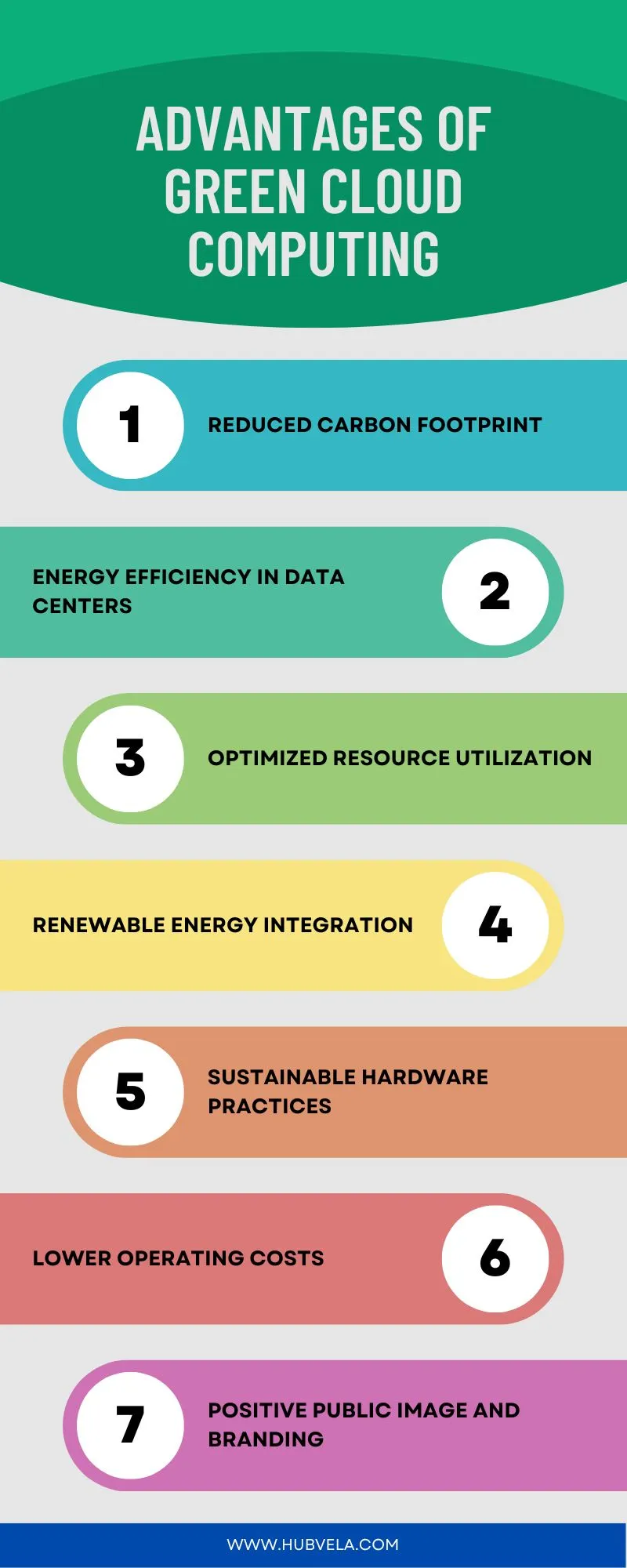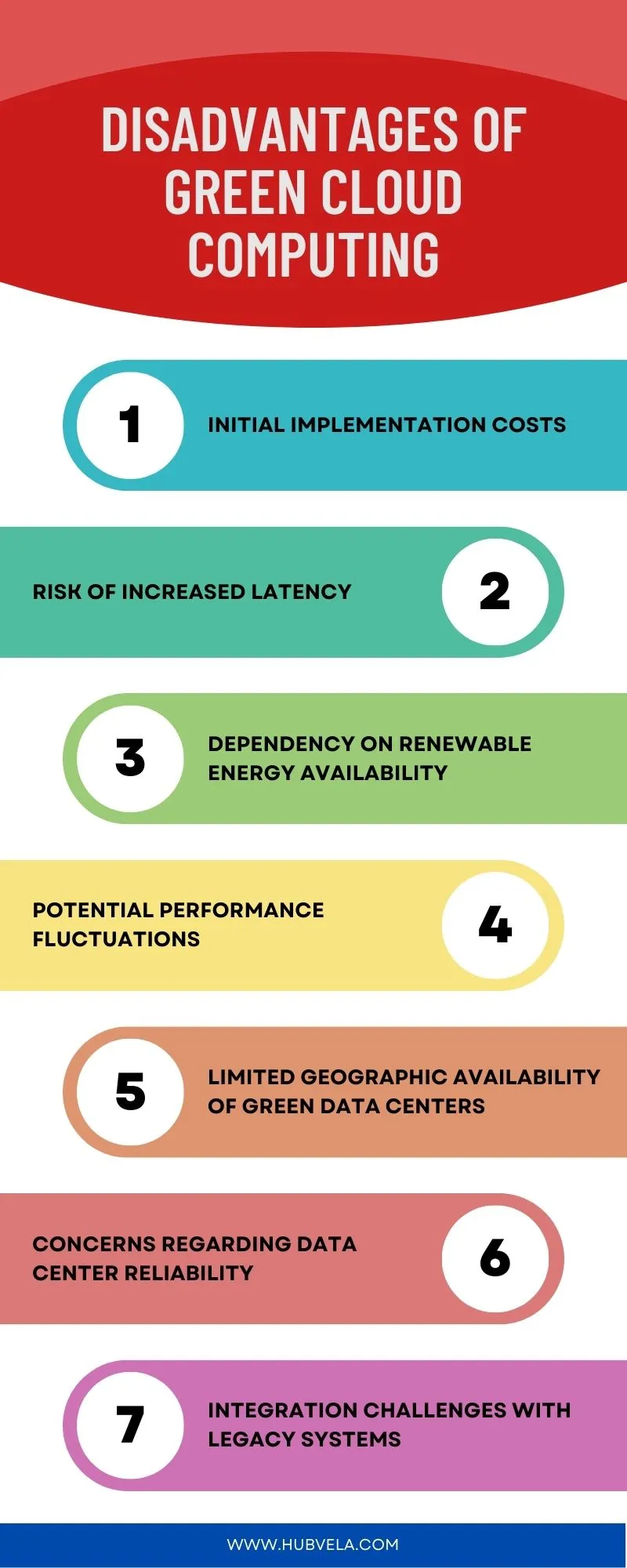Green cloud computing is a practice that aims to reduce the environmental impact of cloud computing by utilizing resources more efficiently and reducing energy consumption.
As more and more organizations become environmentally conscious, green cloud computing is gaining popularity. It has several advantages, such as reduced energy consumption, decreased greenhouse gas emissions, and cost-effectiveness.
However, there are also some disadvantages, such as higher initial implementation costs and sacrificing performance to improve battery life. In this article, we will explore the advantages and disadvantages of green cloud computing in more detail.

--Advertisement--
Advantages of Green Cloud Computing
Green cloud computing refers to the environmentally friendly use of cloud computing technologies to reduce energy consumption, minimize carbon emissions, and promote sustainability.
This approach involves leveraging cloud infrastructures to achieve greater energy efficiency and decrease the environmental impact of data centers. We will delve into some major benefits of green cloud computing.

1. Reduced Carbon Footprint
Green cloud computing refers to the environmentally friendly use of technology to reduce energy consumption and minimize the carbon footprint associated with cloud computing.
By leveraging energy-efficient technologies and renewable energy sources, large public cloud providers such as Microsoft, AWS, and Google Cloud aim to decrease their environmental impact.
This is achieved through reduced energy consumption, decreased greenhouse gas emissions, and the use of renewable electricity sources like wind and solar farms.
Green cloud computing also enables remote work, reducing traffic congestion, lowering energy use at workplaces, and ultimately contributing to environmental sustainability.
By adopting green cloud computing, organizations can significantly decrease their carbon footprint and promote a more sustainable environment.
2. Energy Efficiency in Data Centers
Green cloud computing is the practice of moving to cloud infrastructures where data centers utilize resources more efficiently and consume less energy.
Energy efficiency in data centers is one of the key advantages of green cloud computing. Large cloud providers such as Azure, AWS, and Google Cloud make it a point to purchase large amounts of renewable energy, either indirectly through energy certificates or directly from a power supplier that generates electricity from renewable sources such as wind and solar farms.
This helps to reduce energy consumption and decrease greenhouse gas emissions, which is beneficial for the environment.
Additionally, virtualization and power management are other techniques used in green cloud computing to maximize the quantity of available system resources in an environment-friendly way.
Green cloud computing is an effective way to reduce energy consumption and promote environmental sustainability in the IT industry.
3. Optimized Resource Utilization
Optimized resource utilization in green cloud computing refers to the efficient use of computing resources to minimize energy consumption and environmental impact.
Green cloud computing aims to reduce energy consumption, decrease greenhouse gas emissions, and promote environmental sustainability by leveraging technologies such as virtualization, multitenancy, and power management.
Large cloud providers like Microsoft, AWS, and Google Cloud purchase renewable energy and aim to source 100% of their electricity from renewable sources, contributing to optimized resource utilization and reduced environmental impact.
By adopting green cloud computing, organizations can pool their resources, reduce power consumption, and achieve a noticeable decrease in energy bills, while also improving customer experience and promoting remote work, which further reduces energy use and carbon emissions.
Optimized resource utilization in green cloud computing plays a crucial role in minimizing the carbon footprint of organizations and promoting a more sustainable environment.
4. Renewable Energy Integration
Renewable energy integration is a key aspect of green cloud computing, which aims to reduce the environmental impact of cloud infrastructures by utilizing resources more efficiently and promoting the use of renewable energy sources.
Large public cloud providers such as Microsoft, AWS, and Google Cloud are actively striving to power their data centers with renewable energy sources like wind and solar power, with the goal of sourcing 100% of their electricity from renewable sources in the near future.
By purchasing considerable amounts of renewable electricity and achieving higher IT operational and infrastructure efficiencies, these providers can significantly reduce energy consumption and carbon footprint, making green cloud computing an environmentally friendly choice for businesses and organizations.
The integration of renewable energy in green cloud computing not only reduces energy consumption but also promotes environmental sustainability, making it a crucial component in the future of business cloud computing.
5. Sustainable Hardware Practices
Sustainable hardware practices play a crucial role in the advancement of green cloud computing, offering several advantages in terms of energy efficiency, reduced carbon emissions, and overall environmental sustainability.
Green cloud computing encompasses a set of beneficial practices aimed at minimizing energy consumption and carbon emissions, promoting the use of renewable energy sources, and maximizing energy efficiency.
This approach involves the deployment of green hardware, which refers to the physical components and devices used in computing designed with an emphasis on energy efficiency, reduced environmental impact, and sustainability.
Green hardware includes servers, storage devices, networking equipment, and other related infrastructure, all of which contribute to the overall goal of achieving a sustainable digital future.
By embracing sustainable hardware practices, cloud providers can significantly reduce energy consumption, minimize carbon emissions, and promote the use of renewable energy sources, thereby contributing to a more environmentally friendly cloud infrastructure.
These efforts not only benefit the environment but also align with broader environmental, social, and governance (ESG) initiatives, ensuring that business practices are ethical and fair.
Major cloud providers such as Amazon Web Services (AWS), Google Cloud, and Microsoft have committed to using 100% renewable energy in their data centers, further emphasizing the importance of sustainable hardware practices in green cloud computing.
6. Lower Operating Costs
Green cloud computing offers several advantages, including lower operating costs. By moving to cloud infrastructures that utilize resources more efficiently and purchase renewable electricity, organizations can reduce their energy consumption and decrease their carbon footprint, leading to cost savings.
Large public cloud providers like Microsoft, AWS, and Google Cloud aim to source 100% of their electricity from renewable sources, which can significantly reduce energy expenses.
Additionally, by pooling resources and reducing the quantity of on-premise equipment, organizations can decrease power consumption and realize a noticeable downfall in their energy bills.
Green cloud computing also enables the development of software and apps that support remote work, reducing traffic congestion, lowering energy use at workplaces, and increasing productivity, all of which contribute to lower operating costs.
7. Positive Public Image and Branding
Green cloud computing has several advantages, including a positive public image and branding. By adopting green cloud computing practices, companies can demonstrate their commitment to environmental sustainability, which can enhance their reputation and brand image.
Green cloud computing can also help companies attract environmentally conscious customers and employees who value sustainability.
Additionally, by reducing their carbon footprint and energy consumption, companies can save on energy costs and improve their bottom line, which can further enhance their public image and brand.
Disadvantages of Green Cloud Computing
While there are several advantages to adopting green cloud computing, such as reduced carbon footprint, energy efficiency in data centers, and improved public image, there are also several disadvantages that need to be considered.
We will delve deeper into the disadvantages of green cloud computing and explore the challenges associated with its implementation and adaptation.

1. Initial Implementation Costs
The initial implementation costs of green cloud computing are perceived to be high, particularly for medium-sized and small organizations.
This initial investment may seem costly and not affordable for everyone. The high implementation cost is a significant disadvantage associated with the adoption of green computing, making it challenging for organizations to adapt to this technology immediately.
Despite the potential long-term benefits in terms of energy efficiency and environmental impact, the upfront financial burden remains a barrier for many businesses.
Therefore, while green cloud computing offers environmental advantages, the high initial investment poses a notable disadvantage, especially for smaller enterprises.
2. Risk of Increased Latency
One of the disadvantages of green cloud computing is the risk of increased latency, which refers to the delay in data transmission between the user and the cloud server.
This delay can have various negative impacts, such as affecting the real-time nature of certain applications and services. For instance, in critical industries like healthcare, high latency can lead to delays in the transmission of patient health data, potentially impacting patient care and outcomes.
Moreover, high latency can result in poor user experience, causing buffering and lagging when streaming media or accessing cloud-based applications, which can frustrate users and negatively impact customer retention.
Additionally, latency issues can lead to network outages or failures, causing service disruptions and potential data loss, which can be detrimental for businesses running critical operations on the cloud.
Therefore, while green cloud computing offers environmental benefits, it is essential to address and mitigate the risk of increased latency to ensure efficient and reliable cloud computing operations.
3. Dependency on Renewable Energy Availability
One of the disadvantages of green cloud computing is the dependency on renewable energy availability. Cloud data centers operating on renewable energy resources lead to zero greenhouse gas emissions, but the associated cost and unpredictable supply of renewable resource are major drawbacks.
The efficiency of renewable energy generation and storage mediums needs to be rigorously increased in order to provide comparable business incentives.
Furthermore, the demand for computer power requires more energy, consumes more natural resources, and produces more greenhouse gas emissions.
As a result, the environmental impact of cloud computing is drawing greater scrutiny that requires business and IT leaders to take action.
4. Potential Performance Fluctuations
Green cloud computing, while offering various advantages such as energy conservation and cost-effectiveness, also presents certain disadvantages.
One of the potential drawbacks is the possibility of performance fluctuations. This can occur due to the implementation of green computing practices, which may sacrifice performance to improve battery life and reduce energy consumption.
Additionally, the initial implementation of green computing requires higher start-up costs, which can impact the performance of the computing systems.
Therefore, organizations considering the adoption of green cloud computing should carefully evaluate the trade-offs between environmental benefits and potential performance fluctuations to make informed decisions about its implementation.
5. Limited Geographic Availability of Green Data Centers
Green data centers, which operate efficiently with minimal environmental impact, are crucial for reducing the carbon footprint of data centers.
However, the geographic placement of data centers can lead to varying environmental impacts, such as water and energy utilization.
Research indicates that the total water intensity, water scarcity intensity, and carbon intensity of a data center can vary significantly depending on its location.
This highlights the importance of strategically locating data centers in areas that minimize environmental footprints. However, challenges such as limited access to renewable energy sources and local market supply monopolies can hinder the transition to green data centers.
6. Concerns Regarding Data Center Reliability
Concerns regarding data center reliability are a significant aspect of the disadvantages of green cloud computing. While green cloud computing aims to reduce power consumption and energy bills by pooling resources and minimizing the quantity of on-premise equipment, concerns about the reliability of data centers persist.
The staggering ecological impacts of computation and the cloud, including the high energy consumption of data centers, raise questions about the reliability of green cloud computing infrastructure.
For instance, the location of data centers and their power utilization, especially in regions with “dirty” electricity grids, can affect the reliability and sustainability of green cloud computing.
Additionally, the initial implementation cost and frequent changes in technology associated with green computing can pose challenges to its widespread adoption.
Despite the environmental benefits, concerns about the reliability and sustainability of data centers remain a key consideration in the context of green cloud computing.
7. Integration Challenges with Legacy Systems
Integrating legacy systems with green cloud computing presents several challenges. Legacy applications are often built on specific hardware, operating systems, and software versions, making their migration to the cloud challenging due to compatibility issues.
This may require modification or modernization to align with the virtualized environment, involving translating data between different formats, implementing secure authentication mechanisms, and establishing robust monitoring and error-handling procedures to safeguard against potential points of failure in the integration process.
Additionally, when a business moves legacy systems to the cloud, it may retain its old culture and approach to infrastructure, leading to significant issues such as unexpected cloud bills and unwanted security vulnerabilities.
Therefore, organizations need to address these challenges to ensure a smooth and secure integration of legacy systems with green cloud computing, enabling them to leverage the benefits of eco-conscious cloud solutions while overcoming the disadvantages associated with legacy systems.
Conclusion on Advantages and Disadvantages of Green Cloud Computing
In conclusion, green cloud computing has several advantages, including reduced energy consumption, decreased greenhouse gas emissions, cost-effectiveness, improved customer experience, and improved public image.
It also encourages reuse and recyclability, uses non-toxic components, and reduces the quantity of heat produced from computing devices.
However, there are also some disadvantages, such as higher initial implementation costs, frequent changes in technology, and sacrificing performance to improve battery life.
Despite these drawbacks, green computing is an important step towards promoting environmental sustainability and reducing the negative impact of computing on the environment.


